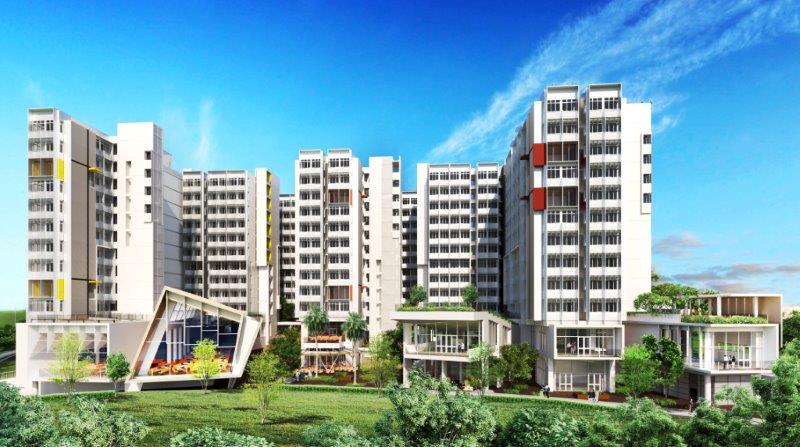 Singapore has been one of the busiest locations in the 3D printing industry lately. The city-state has made 3D printing a major priority, with several large centers and organizations dedicated to the technology. There’s the Global Additive Manufacturing Center of Excellence, and the National Additive Manufacturing Innovation Cluster, which is led by experts from Nanyang Technological University (NTU). Also a part of NTU is the Singapore Centre for 3D Printing, which is working on one of the most daring uses of the technology yet: 3D printed public housing.
Singapore has been one of the busiest locations in the 3D printing industry lately. The city-state has made 3D printing a major priority, with several large centers and organizations dedicated to the technology. There’s the Global Additive Manufacturing Center of Excellence, and the National Additive Manufacturing Innovation Cluster, which is led by experts from Nanyang Technological University (NTU). Also a part of NTU is the Singapore Centre for 3D Printing, which is working on one of the most daring uses of the technology yet: 3D printed public housing.
 Innovations in building construction are slow to take hold, understandably: most people would rather live and work in buildings that have been constructed via traditional, proven methods than ones that have been built using experimental, unproven techniques. In the construction industry, safety should, of course, come before anything else, but that doesn’t mean that new methods shouldn’t be considered and possibly implemented after thorough testing. 3D printing has been discussed for years as the potential future of architecture, and it’s very slowly starting to take hold. We’ve seen temporary 3D printed office spaces, and 3D printed bridges. Many organizations are developing ways of 3D printing major structural elements, and creative ideas for 3D printed walls and interior design elements are flowing like crazy.
Innovations in building construction are slow to take hold, understandably: most people would rather live and work in buildings that have been constructed via traditional, proven methods than ones that have been built using experimental, unproven techniques. In the construction industry, safety should, of course, come before anything else, but that doesn’t mean that new methods shouldn’t be considered and possibly implemented after thorough testing. 3D printing has been discussed for years as the potential future of architecture, and it’s very slowly starting to take hold. We’ve seen temporary 3D printed office spaces, and 3D printed bridges. Many organizations are developing ways of 3D printing major structural elements, and creative ideas for 3D printed walls and interior design elements are flowing like crazy.
The idea of a 3D printed high-rise building is something different, though. While it’s showing itself to be a reliable method of construction in many forms, it’s still so new and relatively untested that it’s a scary prospect for a lot of people – especially when considering living in a printed apartment building thousands of feet off the ground. But that’s precisely the idea that the Singapore Centre for 3D Printing wants to test.
The idea, according to the Centre’s Executive Director Professor Chua Chee Kai, is to print the buildings one story at a time, then transport them to the construction site and stack them like Legos. This “Lego-style” fabrication method, officially known as “Prefabricated Pre-Finished Volumetric Construction,” has already been used to build three new residence halls at NTU, although the individual stackable modules are built with more traditional construction methods.
Not every element of the public housing buildings would be 3D printed, but the major structural components would be. The Centre, which is working with a private company to test the idea, intends to formally present it to government agencies later this year. If all goes according to plan, a prototype could be developed within three years. But first, some extra-large printers will have to be developed – large enough to print major building parts.
“In the area of housing there are quite big challenges,” said Professor Chua. “There is no assistance of 3D printers and no availability of printable concrete. We have to develop all this from scratch.”
 They certainly should have the resources to do so, though. The Singapore Centre for 3D Printing was set up with $150 million by the government and local industry for the purpose of researching ways that 3D printing can be used within the city. Singapore currently depends heavily on foreign workers for construction, which, combined with an aging population, creates some urgency for the government to develop more productive, less labor-intensive construction methods. The Centre is also researching the potential to 3D print weapons parts for the military, as well as multiple healthcare applications. Discuss in the Singapore 3D Printed High Rises forum over at 3DPB.com.
They certainly should have the resources to do so, though. The Singapore Centre for 3D Printing was set up with $150 million by the government and local industry for the purpose of researching ways that 3D printing can be used within the city. Singapore currently depends heavily on foreign workers for construction, which, combined with an aging population, creates some urgency for the government to develop more productive, less labor-intensive construction methods. The Centre is also researching the potential to 3D print weapons parts for the military, as well as multiple healthcare applications. Discuss in the Singapore 3D Printed High Rises forum over at 3DPB.com.
Subscribe to Our Email Newsletter
Stay up-to-date on all the latest news from the 3D printing industry and receive information and offers from third party vendors.
You May Also Like
Precision at the Microscale: UK Researchers Advance Medical Devices with BMF’s 3D Printing Tech
University of Nottingham researchers are using Boston Micro Fabrication‘s (BMF) 3D printing technology to develop medical devices that improve compatibility with human tissue. Funded by a UK grant, this project...
3D Printing Webinar and Event Roundup: April 21, 2024
It’s another busy week of webinars and events, starting with Hannover Messe in Germany and continuing with Metalcasting Congress, Chinaplas, TechBlick’s Innovation Festival, and more. Stratasys continues its advanced training...
3D Printing Webinar and Event Roundup: March 17, 2024
It’s another busy week of webinars and events, including SALMED 2024 and AM Forum in Berlin. Stratasys continues its in-person training and is offering two webinars, ASTM is holding a...
3D Printed Micro Antenna is 15% Smaller and 6X Lighter
Horizon Microtechnologies has achieved success in creating a high-frequency D-Band horn antenna through micro 3D printing. However, this achievement did not rely solely on 3D printing; it involved a combination...






























